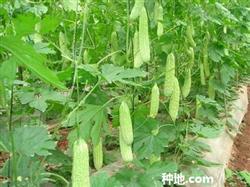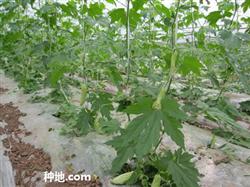How to control whitefly in greenhouse balsam pear?

How to control whitefly in greenhouse balsam pear? Greenhouse whitefly, also known as greenhouse whitefly, belongs to Homoptera, whitefly family. In the late 1970s, with the expansion of greenhouse, plastic greenhouse and other protected vegetables, the occurrence and distribution of this insect showed a trend of expansion and spread. at present, it has occurred and damaged in most parts of our country, and has become an important pest of vegetables cultivated in greenhouse. Greenhouse whitefly mainly uses adults and nymphs to suck plant sap on the back of the leaves, making the leaves fade to yellow, wilt and even die, affecting the normal growth and development of crops. At the same time, a large amount of honeydew secreted by adults accumulates on the leaves and fruits, causing coal fouling disease, seriously affecting photosynthesis and respiration, and reducing crop yield and quality. In addition, the worm can also spread some viruses. There are many host plants of whitefly in greenhouse. There are more than 200 kinds of vegetables, flowers and crops alone. It mainly harms cucumber, tomato, eggplant, pepper, watermelon, wax gourd, cabbage, cowpea, lentil, lettuce, celery and so on. Morphological recognition 1. The length of the adult is about 0.8-1.4 mm. Yellowish white to white, both sexes have wings, and the wings are covered with white wax powder. When the female adult is at rest, the wings are flat, while the male is slightly tilted upward to form a roof ridge. two。 The egg is long and oval, 0.2 to 0.25 mm in diameter. It was yellowish at first birth, and then gradually changed to dark brown. The egg has a stalk and is laid on the back of the leaf. 3. Nymphs are oval and flat. The body length of 1-year-old, 2-year-old and 3-year-old are 0.29 mm, 0.38 mm and 0.52 mm, respectively. Light green, translucent, with uneven filamentous protuberances on the body surface. 4. The pupa is the 4th instar nymph. The body length is 0.7-0.8 mm, oval, milky white or yellowish, and there are usually 8 pairs of waxy filamentous protuberances on the back. The occurrence regularity of greenhouse whitefly can occur for more than 10 generations a year under greenhouse conditions, and it can overwintering or continue to harm greenhouse vegetables in various insect states. In winter, in warm areas, eggs can survive the winter on Compositae. In the following spring, it gradually migrated and spread from the overwintering site to the sunny border and open field vegetables and flowers. The population density increased slowly from May to June, and increased rapidly from July to August, and the harm was the most serious from August to September. After late October, the temperature decreased, the population gradually decreased, and began to migrate to the greenhouse for harm or overwintering. Greenhouse whitefly adults have a strong tendency to yellow, but avoid white, silver, and are not good at flying. It happens little by little in the field, and then gradually spreads. The distribution of insect population density in the field is uneven, and the adults like to cluster on the back of the upper tender leaves and lay eggs on the tender leaves. With the growth of the plant, the adults continue to transfer to the upper leaves, so the distribution of each insect state on the plant forms a certain rule: the uppermost tender leaves, the adults and the first yellowish eggs are the most; the lower leaves are mostly dark brown eggs; and then the lower parts are early nymphs, aged nymphs and pupae. The emergence time of adults is concentrated in the early morning. The female adults lay eggs after 1-3 days of mating. The eggs are mostly laid on the back of the leaves, and the egg stalk is inserted into the leaf tissue from the stomata to maintain water balance with the host and is not easy to fall off. Each female lays 120 to 130 eggs, with a maximum of 534 eggs. The optimum temperature for adult activity of whitefly in greenhouse is 25: 30 ℃. Eggs, older nymphs and "pupae" are highly resistant to temperature and pesticides. . the greenhouse whitefly is selective to the host, and the occurrence is large and harmful in the greenhouse where cucumber and tomato are mixed. The hosts that did not like to eat whitefly were lighter when they were planted or planted alone. According to the investigation, the number of insect population of whitefly in greenhouse in autumn is more than that in spring greenhouse, the number of vegetables in open field is more than that in spring and autumn greenhouse, and the vegetable field near the greenhouse is more distant than that in spring and autumn, and the harm is also serious. Prevention and control methods 1. Agricultural control 1) disinfect greenhouse and seedlings before cultivating insect-free seedlings. The greenhouse was fumigated with 0.4-0.6 kg of 80% dichlorvos per mu, or sprayed with 1000 times of 40% omethoate EC. 2) rational layout in the open field near the shed to avoid planting melons, eggplant fruits, beans and other white whitefly parasitic and serious vegetables, and advocate the cultivation of cruciferous vegetables that whitefly does not like to eat. Avoid mixed planting of cucumber, tomato and kidney bean in greenhouse, prevent whitefly from spreading each other, aggravate the harm and increase the difficulty of control. 3) seal the nylon yarn in the vents of the shed to control the source of exotic insects. When insect pests occur, combine the power of pruning and beating, remove the old leaves with insects, and take them out of the shed to bury or burn. two。 The yellowing habit of whitefly in greenhouse was used for physical control. in the early stage of the occurrence of whitefly, the yellow plate coated with engine oil was placed in the greenhouse, which was higher than vegetable plants and induced the adults of whitefly. 3. When the occurrence amount of whitefly in vegetables in the biological control shed was 0.5 × 1 / plant, the "black pupa" of aphid wasp could be released, 3 × 5 per plant, once every 10 days, a total of 3 × 4 times, and the parasitism rate was more than 75%. The effect of controlling white whitefly is better. 4. Chemical control 1) smoke method: 0.5 kg of 22% dichlorvos smoke agent per mu in greenhouse, or 0.4 kg 0.5 kg per mu of dichlorvos EC, sprinkled on sawdust and other carriers, plus a few red-hot briquettes. 2) spray with 1000 times of 10% chlorpromazine EC, or 1000 times of 10% imidacloprid wettable powder, or 2.5% Uranus EC 2000 times, or 2.5% Kung Fu EC 3000 times, or 20% methotrexate EC 2000 times or 40% dimethoate EC 1000 times, or 80% dichlorvos EC 1000 times, or 25% dichlorvos EC 1000 times, spray once every 5 days for 3 times in a row. Due to the overlap of generations of whitefly, there are all kinds of insect states on the same crop at the same time, but the pesticides currently used are not suitable for all insect states, so the pesticide must be used several times in order to achieve good control effect. Click to get more balsam pear planting techniques click to get more vegetable planting techniques
- Prev

How to cultivate balsam pear scientifically?
How to cultivate balsam pear scientifically? Please advise 1. Variety characteristics "Xinxing balsam pear" is a medium-ripe hybrid of Guangzhou Epunong Agricultural Science and Technology Co., Ltd., with trailing plants, strong growth potential and strong branching power, and both main and lateral vines can bear melon. The leaves are palmately shaped and green, and the first female flower node of the main vine begins to bear female flowers at nodes 15-20.
- Next

How to cultivate balsam pear in open field?
How to cultivate balsam pear in open field? Please guide Momordica charantia scientific name for Momordica L. alias has cold melon, golden litchi, said the grape, is a gourd family Momordica cultivated species, an annual climbing herb. It originated in subtropical regions; in South China, North China, Central China, Southwest China are planted...
Related
- Where is it suitable to grow horseradish in China? it is expected to see the middle altitude horseradish in Alishan.
- How to prevent tomato virus disease reasonably? (Control methods included)
- Many people like to plant towel gourd on the balcony. What are the main points of this method and management?
- What crops can chili peppers be mixed with?
- Fertilization techniques and matters needing attention in Tomato
- What are the grafting techniques for peach seedlings in spring?
- Harm and control methods of root swelling disease of Chinese cabbage
- What are the pests of sweet potatoes? How to prevent and cure it?
- Symptoms, causes and Control methods of navel Rot in Tomato
- The cause of "Cucumber rotten bibcock" in Farmers' planting Cucumber and its Control Plan

